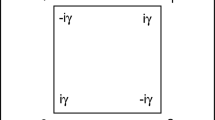Abstract
Using a suitably noncommutative flat matrix model, it is shown that the quantum permutation group has free orbitals: that is, a monomial in the generators of the algebra of functions can be zero for trivial reasons only. It is shown that any strictly intermediate quantum subgroup between the classical and quantum permutation groups must have free three-orbitals, and this is used to derive some elementary bounds for the Haar state on degree four monomials in such quantum permutation groups. Exploiting the main character, explicit formulae are given in the case of the quantum permutation group.
Similar content being viewed by others
Notes
In the notation of [9, (1)], \(x\in M_0\).
References
Banica, T.: Homogeneous quantum groups and their easiness level. Kyoto J. Math. 61, 1–30 (2021)
Banica, T.: Introduction to Quantum Groups. Springer Nature, Cham (2023)
Banica, T.: Higher orbitals of quizzy quantum group actions. Adv. Appl. Math. 109, 1–37 (2019)
Banica, T., Bichon, J.: Quantum groups acting on 4 points. J. Reine Angew. Math. 626, 74–114 (2009)
Banica, T., Bichon, J.: Hopf images and inner faithful representations. J. Reine Angew. Math. 626, 74–114 (2009)
Banica, T., Collins, B.: Integration over the Pauli quantum group. Glasgow Math. J. 52, 677–704 (2010)
Banica, T., Nechita, I.: Flat matrix models for quantum permutation groups. Adv. Appl. Math. 83, 24–46 (2017)
Bichon, J.: Algebraic quantum permutation groups. Asian-Eur. J. Math. 1, 1–13 (2008)
Böttcher, A., Spitkovsky, I.M.: A gentle guide to the basics of two projections theory. Linear Algebra Appl. 432(6), 1412–1459 (2010)
Brannan, M., Chirvasitu, A., Freslon, A.: Topological generation and matrix models for quantum reflection groups. Adv. Math. 363, 1–26 (2020)
Huang, H.: Compact quantum group actions on compact quantum spaces. PhD Thesis, University of Buffalo (2013)
Lupini, M., Mančinska, L., Roberson, D.E.: Nonlocal games and quantum permutation groups. J. Funct. Anal. 279, 1–39 (2020)
McCarthy, J.P.: A state-space approach to quantum permutations. Exp. Math. 40(3), 628–664 (2022)
Wang, S.: Quantum symmetry groups of finite spaces. Comm. Math. Phys. 195, 195–211 (1998)
Wang, Simeng: \(L_p\)-improving convolution operators on finite quantum groups. Indiana Univ. Math. J. 65, 1609–1637 (2016)
Woronowicz, S.L.: Compact matrix pseudogroups. Comm. Math. Phys. 111, 613–665 (1987)
Acknowledgements
Some of this work goes back to discussions with Teo Banica, and free orbitals in \(S_4^+\) are due to Teo. Thanks to David Roberson to pointing to Definition 4.1 in his pre-print Quantum symmetry vs nonlocal symmetry with Simon Schmidt. The idea for the magic basis which gives the flat matrix model comes from this definition. The question of inner faithfulness was posed by Uwe Franz.
Author information
Authors and Affiliations
Corresponding author
Additional information
Publisher's Note
Springer Nature remains neutral with regard to jurisdictional claims in published maps and institutional affiliations.
Rights and permissions
Springer Nature or its licensor (e.g. a society or other partner) holds exclusive rights to this article under a publishing agreement with the author(s) or other rightsholder(s); author self-archiving of the accepted manuscript version of this article is solely governed by the terms of such publishing agreement and applicable law.
About this article
Cite this article
McCarthy, J. Tracing the orbitals of the quantum permutation group. Arch. Math. 121, 211–224 (2023). https://doi.org/10.1007/s00013-023-01883-w
Received:
Revised:
Accepted:
Published:
Issue Date:
DOI: https://doi.org/10.1007/s00013-023-01883-w



